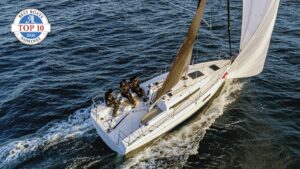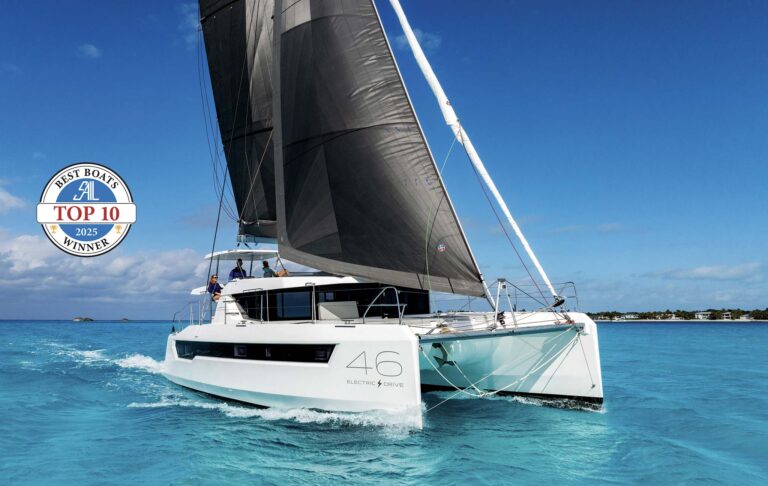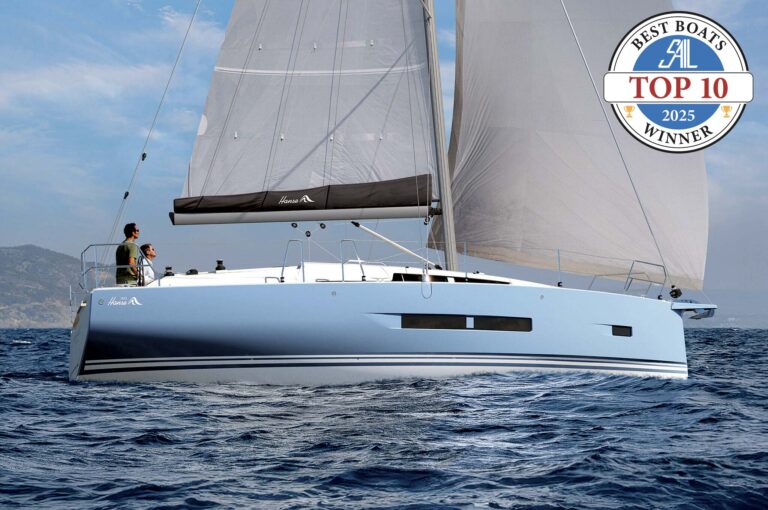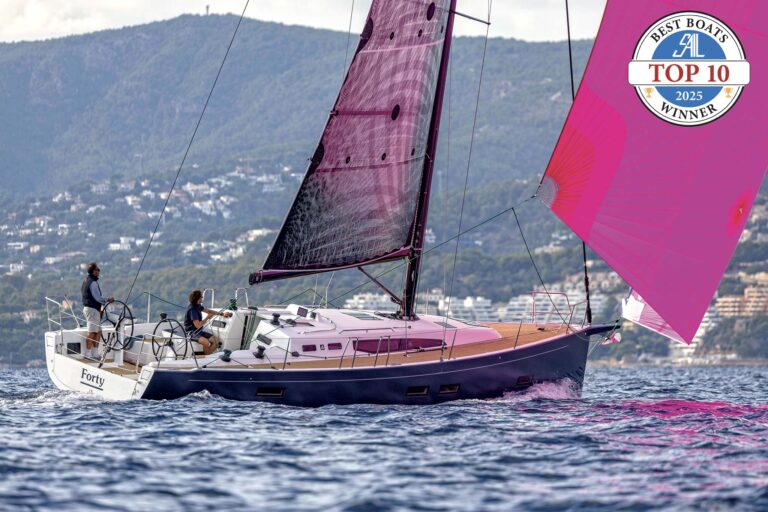
These days, when boats are selling like hotcakes, it may be tempting to sit back and ease up on the innovation process. After all, why spend R&D money developing something new when it’s easy to sell what already exists? Thankfully, Beneteau has chosen a very different path as it continues to improve and strengthen its line, an effort that is clearly in the Beneteau Oceanis 34.1, which takes the place of the Oceanis 35.1.
Design & Construction
The new model is the sixth in the Oceanis “.1” line and features an all-new hull drawn by Marc Lombard, Beneteau’s latest go-to designer. Like her smaller sibling, the Oceanis 30.1, the new model is built in Poland, a country with a long, proud history of shipbuilding. Eric Levine, Beneteau sales manager, noted that the monolithic hull includes a hard chine to help with stability. The boat also has approximately 3in less beam to either side and is about 1,000lb lighter than its predecessor. “The focus with this model has been on better performance, especially in light air,” he said, noting. “We also added some more sail area (up to 29 percent more depending on how the boat is specced), so she’s guaranteed to sail well.”
The fractional Seldén rig includes twin swept spreaders, a rigid vang and no backstay. A composite bowsprit is optional, but is, in fact, an absolute must as an attachment point for hoisting a Code 0 or some other kind of A-sail whenever things go light. Aesthetically, the sprit also helps the hull to look both more complete. Total sail area is 531ft2 when you combine a classic (hoisted) mainsail and self-tacking jib. Choosing the optional 106-percent furling genoa or the square top main (which adds another 40ft of sail area) will make this one slippery boat.
Twin rudders come standard and there are two fixed-keel options: shoal (4ft 11in) and deep (6ft 7in). Owners can also go with a hydraulically operated lifting keel, which goes from 4ft 1in to 8ft 4in and will deliver a combination of excellent performance sailing hard on the wind, while still allowing you to sneak into skinnier water in search of the best anchorages.
On Deck
Step aboard via the manually operated drop-down transom, and you’ll find yourself standing between a pair of helm seats that fold up and out of the way to provide a little more space when not in use. The twin wheels are mounted on a set of integrated binnacles that serve as extensions of the cockpit coamings. A large drop-leaf table that sits between two well-proportioned benches with enough space to host four for dinner with ease.
A lovely (and functional) option at the transom is a set of chocks to either side to manage dock lines. It’s a nice big-boat feature that helps reduce the strain on the cleats aft. The pair installed on our test boat looked more than up to the task of handling the requisite hefty loads. The decks are clear as you make your way forward, and thanks to the low coachroof, it’s easy to get around quickly. Teak slatting on the swim platform and an electric halyard winch at the companionway are available as options. The chartplotter is located to starboard with instrument repeaters to port. Twin sheet winches close at hand making it easy to adjust the sails from the helms.

Accommodations
Belowdecks, the Oceanis 34.1 is generous and then some in terms of its accommodation spaces. You’d never guess you’re on a boat with a length on deck of under 35ft and less than 12ft of beam. Descend the companionway you find an L-shaped galley to starboard with a two-burner Eno stove, a top-loading fridge and double trash bins for easy recycling. A microwave and 2,000-watt inverter to power it is optional.
Continuing on into the saloon proper it doesn’t take long to discover the boat also has a few tricks up its sleeve. To start out with, you notice how wide the settees are despite the narrower hull. Per Levine, this was done on purpose to make for more comfortable sleeping. The port settee also serves as the seat for an aft-facing fold-up nav desk. With the desk out of the way, inserting a cushion at the aft end converts it to an additional berth.
Finally, there’s the head to port, which expands from a wet head in the three-cabin version to a large bath with a separate shower stall if two cabins are spec’d. In lieu of a third cabin, you’ll also get a generous amount of extra stowage space aft, which can be accessed from either the shower stall or the port bench hatch in the cockpit.
The master cabin is forward and includes an overhead hatch as well as hull windows that make for a satisfyingly bright living space. Entry is via a bifurcated door that’s been expressly designed to allow the berth to extend as far aft as possible. With the door open, the boat naturally looks more spacious as the eye is drawn forward. That said, taller skippers may opt to take over the starboard stateroom aft, both for it bigger bed and the extra standing space there. It will, of course, also be more comfortable sacking out aft in any kind of a seaway on-passage.
The standard wood choice is Alpi walnut. However, light oak is also available as an option. As per Levine, about 20 percent of his clientele opts for the darker, more traditional color scheme. During the day and especially with the lighter finishes, the boat is bright and inviting. At night, it may benefit from the addition of some courtesy lighting, which would also add the same kind of luxurious effect seen aboard many larger yachts out there.
Under Sail
We tested hull #3 of the Oceanis 34.1 in Miami in feisty conditions, with true winds of 15-20 knots or more, gusting substantially higher on occasion. After hoisting the full main, we started out by only partially unrolling the genoa, which like the main was constructed by Technique Voile out of Dacron. In 19 knots true, we logged a fun 7.6 knots over the ground, which ticked up to 8.0 knots at a 60-degree apparent wind angle. Easing off to a beam reach, our speed-over-ground topped 8.3 knots and before falling back to a still impressive 7.2 knots as we ran a fairly deep 135 degrees apparent. Even with five of us aboard, we never once felt in each other’s way. The boat also never felt overpowered, staying on her feet thanks to that chine, making for an exhilarating sail on a fun day.
Under Power
Motoring back to the marina, we found some flat water and opened-up the throttle on the upgraded 30hp Yanmar to reach 8.1 knots at 2,750 rpm. A better cruising speed will be around 7.5 knots with the engine ticking over at about 2,300 rpm. Standard propulsion includes a 21hp diesel. However, with the bigger engine, you’ll also have necessary extra power to push through head seas if you ever need to get home in a hurry. Engine controls are to starboard and down by the knees. A Side Power bow thruster is available as an option and will come in handy in tight marinas.
Conclusion
As always, Beneteau offers plenty of pre-organized packages allowing you to dial in the experience you want. “Easy Sail” is the most basic and comes with the self-tacking jib, taking the pressure of novice sailors and those who like to sail shorthanded. Other “trim levels” include “Comfort” or fully loaded “Family” versions of the boat, while electronics are offered at the “Coastal” and “Offshore” levels. The best part is the three levels of sail outfitting where the highest “Upwind/Downwind” option includes a Code 0, extra winches and jammers, and the bowsprit. Agai, it’s nice to see completely new designs like this making their way to market even when the industry is busier than ever. With the 34.1, Beneteau shows it is clearly not just resting on its laurels.

Specifications
LOA 35ft 4in LWL 31ft 2in Beam 11ft 9in
Draft 4ft 11in (shoal); 6ft 7in (std.)
Displacement 12,046lb
Ballast 3,482lb (std.)
Sail Area 531ft2 (with self-tacking jib)
Fuel/Water (GAL) 34/61
Engine 21 hp Yanmar
D/L Ratio 177
SA/D Ratio 16
Ballast Ratio 29
What do these ratios mean? Visit sailmagazine.com/ratios
Designer Marc Lombard
Builder Beneteau America, Annapolis, MD, beneteauamerica.com
Price $192,000 (base) at time of publication
July/August 2022










